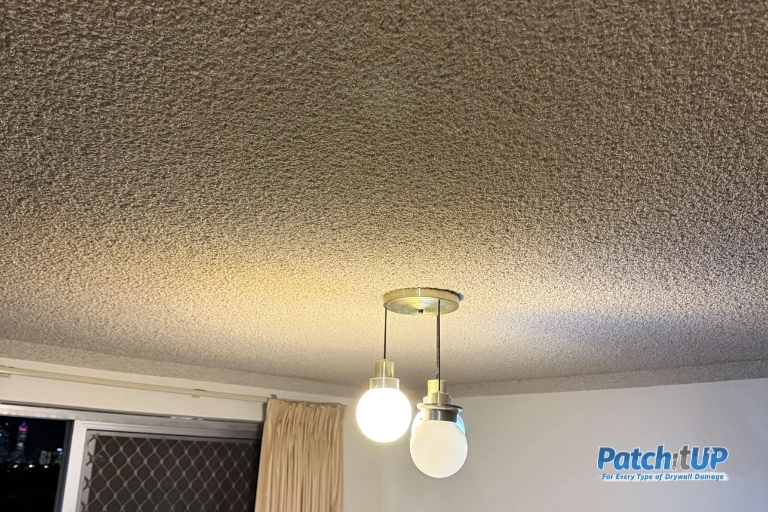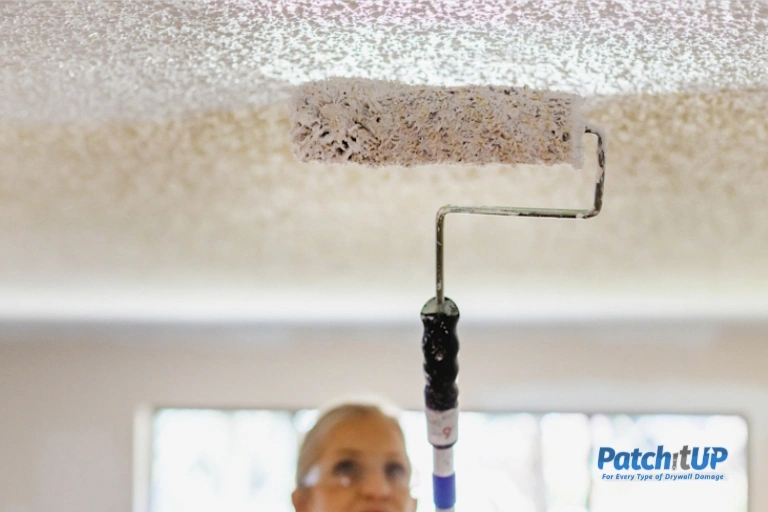A popcorn ceiling is a type of ceiling finish with a rough, bumpy texture that resembles popcorn or cottage cheese. This texture was applied using a spray-on technique and became especially popular in residential construction between the 1950s and the 1980s. Builders often chose popcorn ceilings because they were cost-effective and practical. They were typically used in bedrooms, hallways, and living rooms to hide flaws and improve acoustics.
In the earlier years of use, the spray mixture sometimes included asbestos, a harmful material later banned due to health concerns. Today, popcorn ceilings are often seen as outdated and are being removed or covered up as part of home renovations.

Why Were Popcorn Ceilings Used?
Popcorn ceilings gained popularity among builders for several reasons:
- Efficiency and Speed: Using drywall mud or plaster to smooth out the ceiling took longer than applying the texture. There was less need for skilled labor.
- Cost Savings: It helped cut down on finishing costs because the texture covered imperfections, so there was no need to spend extra time perfecting the surface.
- Sound Absorption: Because of the uneven surface’s capacity to dampen sound, rooms were quieter. This was especially useful in apartment buildings and multifamily residences.
Pros of Popcorn Ceilings
While they are no longer trendy, popcorn ceilings offered some practical advantages:
1. Covers Flaws and Imperfections
One of the biggest reasons popcorn ceilings were used was their ability to hide imperfections such as cracks, stains, or uneven drywall seams. The thick texture made these flaws less noticeable without requiring expensive repairs.
2. Acoustic Benefits
Popcorn ceilings were often referred to as “acoustic ceilings” because the texture could absorb sound. This reduced echo and noise between rooms, which was beneficial in homes with high ceilings or poor soundproofing.
3. Easy to Apply
Spraying on a popcorn texture was faster and easier for construction crews compared to other ceiling finishes. This saved both time and money, especially during large-scale home building.
Cons of Popcorn Ceilings
Over time, homeowners began to notice the downsides of popcorn ceilings. Today, many see them as more of a hassle than a benefit.
1. Outdated Appearance
Popcorn ceilings are often considered old-fashioned. Most modern interior design trends favor clean, smooth ceilings. The rough texture can make a room feel dated, and homes with popcorn ceilings may be harder to sell or may sell for less.
2. Difficult to Clean
Dust, cobwebs, and debris can easily get trapped in the texture. Cleaning a popcorn ceiling is difficult because using too much pressure can damage it, and vacuuming or brushing can make a mess.
3. Hard to Repair
If part of the ceiling becomes stained, damaged, or chipped, it can be hard to patch without the repair standing out. Matching the texture exactly is challenging, and many people end up removing the whole ceiling instead of fixing small sections.
4. Health Concerns (Asbestos Risk)
Many popcorn ceilings installed before 1980 may contain asbestos. If disturbed—during repairs, sanding, or demolition—these ceilings can release asbestos fibers into the air, which is hazardous to health. Asbestos exposure has been linked to serious diseases like mesothelioma and lung cancer. Before making any alterations to older ceilings, testing and expert removal are highly advised.
Modern Alternatives to Popcorn Ceilings
If you’re considering updating your ceiling, there are several modern, attractive alternatives that offer a cleaner and more stylish look.
1. Smooth Finish (Flat Ceiling)
A flat, smooth ceiling is the most common and modern ceiling style. It provides a sleek, clean surface that reflects light well. Though more labor-intensive to create, this style gives the most updated and desirable appearance in today’s homes.
2. Knockdown Texture
This involves applying a light texture that is then smoothed out slightly with a trowel. It still hides some flaws but has a more subtle, appealing finish compared to popcorn. It’s often used in modern homes and renovations.
3. Beadboard or Wood Plank Ceilings
Adding wood planks or beadboard panels to the ceiling brings warmth and character. This is popular in farmhouse, coastal, and rustic-style homes. It’s also a good way to hide a damaged ceiling without tearing it down.
4. Coffered or Tray Ceilings
These are more elaborate ceiling designs where recessed panels or molding are used to create depth and architectural interest. These are usually seen in dining rooms, living rooms, or master bedrooms and add a touch of luxury.
5. Ceiling Tiles or Panels
Ceiling tiles are especially useful in basements or finished garages. They offer easy access to plumbing or wiring and are simple to replace if damaged. Modern styles include sleek, decorative tiles that fit a variety of aesthetics.
Should You Remove a Popcorn Ceiling?
Whether or not to remove a popcorn ceiling depends on a few factors:
- Age of the Ceiling: If the ceiling was installed before 1980, have it tested for asbestos. Never attempt DIY removal without proper safety measures or professional help.
- Condition: If the ceiling is crumbling, stained, or damaged, removal or covering might be the best solution.
- Aesthetic Goals: If you’re renovating for resale or updating your home’s look, replacing the ceiling can greatly improve its appeal.
- Budget: Removal can be costly, especially if asbestos is present. Covering the ceiling with drywall or paneling can be a more affordable option.
Final Thoughts
Popcorn ceilings were once a popular and practical solution in home construction, valued for their sound-dampening ability and ease of installation. However, they’ve since fallen out of favor due to their dated appearance, cleaning difficulties, and potential health risks.
Fortunately, there are numerous appealing and contemporary options available to homeowners today. Whether you decide to cover, remove, or work around a popcorn ceiling, updating it can improve the look, feel, and value of your home. Select a solution that suits your budget and aesthetic preferences, and always seek professional advice if you suspect the presence of asbestos.

FAQ: What Is a Popcorn Ceiling? Pros, Cons, and Modern Alternatives
1. Why do people want to remove popcorn ceilings?
A. People remove popcorn ceilings because they look outdated, collect dust, are hard to clean, and may contain asbestos if old.
2. Is it hard to paint over popcorn ceilings?
A. Yes, painting is difficult. The texture soaks up paint, and applying it evenly without damaging the bumps can be tricky.
3. What are the pros and cons of popcorn ceilings?
A. Pros: Hides ceiling flaws, reduces noise, cheap to install.
Cons: Looks old, hard to clean or repair, may have asbestos, lowers home value.
4. What is the best alternative to popcorn ceilings?
A. A smooth, flat ceiling is the most popular and modern alternative. Other good options include knockdown texture or wood panel ceilings.
Related Post :
- Signs of Ceiling Plaster Damage: Here’s What You Should Do!
- Professional Popcorn Ceiling Removal Near You
- How to Remove Popcorn Ceilings: A Comprehensive Guide

Leave a Reply